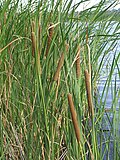Typha angustifolia
Typha angustifolia[edit]
-
Lesser Bulrush in Northumberland
-
Typha angustifolia habitus
Typha angustifolia[edit]
Typha angustifolia, commonly known as narrowleaf cattail, is a perennial herbaceous plant belonging to the family Typhaceae. It is widely distributed across the Northern Hemisphere, particularly in temperate and subtropical regions. This species is often found in wetlands, marshes, and along the edges of ponds and lakes.
Description[edit]
Typha angustifolia is characterized by its tall, slender stems that can reach heights of 1.5 to 3 meters. The leaves are long, narrow, and linear, typically measuring 6 to 12 mm in width, which distinguishes it from other species such as Typha latifolia, which has broader leaves.
The plant produces distinctive cylindrical flower spikes, with the male flowers located above the female flowers on the same spike. The male flowers are yellowish and produce pollen, while the female flowers develop into dense, brown, sausage-shaped structures that persist through the winter.
Habitat and Distribution[edit]
Typha angustifolia thrives in a variety of wetland habitats, including freshwater marshes, brackish marshes, and along the margins of lakes and rivers. It is tolerant of a range of water depths and can grow in both standing and slow-moving water.
This species is native to Europe, Asia, and North America. It has been introduced to other regions, where it can become invasive, outcompeting native vegetation and altering wetland ecosystems.
Ecology[edit]
Typha angustifolia plays a significant role in wetland ecosystems. It provides habitat and food for a variety of wildlife, including birds, insects, and aquatic organisms. The dense stands of cattails offer shelter and nesting sites for birds such as the red-winged blackbird and the marsh wren.
The plant also contributes to the stabilization of wetland soils and the filtration of water, trapping sediments and absorbing nutrients. However, in some areas, its aggressive growth can lead to the displacement of native plant species and a reduction in biodiversity.
Uses[edit]
Historically, Typha angustifolia has been used by humans for various purposes. The leaves and stems have been used for weaving mats, baskets, and chair seats. The fluffy seed heads have been used as stuffing for pillows and mattresses.
In some cultures, the young shoots and rhizomes are consumed as food. The pollen is also edible and can be used as a flour substitute.
Related Pages[edit]
Ad. Transform your life with W8MD's Budget GLP-1 injections from $75


W8MD offers a medical weight loss program to lose weight in Philadelphia. Our physician-supervised medical weight loss provides:
- Weight loss injections in NYC (generic and brand names):
- Zepbound / Mounjaro, Wegovy / Ozempic, Saxenda
- Most insurances accepted or discounted self-pay rates. We will obtain insurance prior authorizations if needed.
- Generic GLP1 weight loss injections from $75 for the starting dose.
- Also offer prescription weight loss medications including Phentermine, Qsymia, Diethylpropion, Contrave etc.
NYC weight loss doctor appointmentsNYC weight loss doctor appointments
Start your NYC weight loss journey today at our NYC medical weight loss and Philadelphia medical weight loss clinics.
- Call 718-946-5500 to lose weight in NYC or for medical weight loss in Philadelphia 215-676-2334.
- Tags:NYC medical weight loss, Philadelphia lose weight Zepbound NYC, Budget GLP1 weight loss injections, Wegovy Philadelphia, Wegovy NYC, Philadelphia medical weight loss, Brookly weight loss and Wegovy NYC
|
WikiMD's Wellness Encyclopedia |
| Let Food Be Thy Medicine Medicine Thy Food - Hippocrates |
Medical Disclaimer: WikiMD is not a substitute for professional medical advice. The information on WikiMD is provided as an information resource only, may be incorrect, outdated or misleading, and is not to be used or relied on for any diagnostic or treatment purposes. Please consult your health care provider before making any healthcare decisions or for guidance about a specific medical condition. WikiMD expressly disclaims responsibility, and shall have no liability, for any damages, loss, injury, or liability whatsoever suffered as a result of your reliance on the information contained in this site. By visiting this site you agree to the foregoing terms and conditions, which may from time to time be changed or supplemented by WikiMD. If you do not agree to the foregoing terms and conditions, you should not enter or use this site. See full disclaimer.
Credits:Most images are courtesy of Wikimedia commons, and templates, categories Wikipedia, licensed under CC BY SA or similar.
Translate this page: - East Asian
中文,
日本,
한국어,
South Asian
हिन्दी,
தமிழ்,
తెలుగు,
Urdu,
ಕನ್ನಡ,
Southeast Asian
Indonesian,
Vietnamese,
Thai,
မြန်မာဘာသာ,
বাংলা
European
español,
Deutsch,
français,
Greek,
português do Brasil,
polski,
română,
русский,
Nederlands,
norsk,
svenska,
suomi,
Italian
Middle Eastern & African
عربى,
Turkish,
Persian,
Hebrew,
Afrikaans,
isiZulu,
Kiswahili,
Other
Bulgarian,
Hungarian,
Czech,
Swedish,
മലയാളം,
मराठी,
ਪੰਜਾਬੀ,
ગુજરાતી,
Portuguese,
Ukrainian

